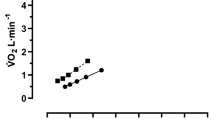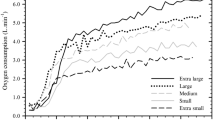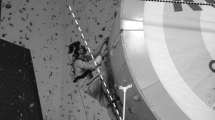Abstract
The purpose of the present article is to identify the most appropriate method of scaling \({\dot{\text V}}_{{\text{O}}_2 \max} \) for differences in body mass when assessing the energy cost of time-trial cycling. The data from three time-trial cycling studies were analysed (N=79) using a proportional power-function ANCOVA model. The maximum oxygen uptake-to-mass ratio found to predict cycling speed was \({\dot{\text V}}_{{\text{O}}_2 \max } (m)^{ - 0.32}, \) precisely the same as that derived by Swain for sub-maximal cycling speeds (10, 15 and 20 mph). The analysis was also able to confirm a proportional curvilinear association between cycling speed and energy cost, given by \({\dot{(\text V}}_{{\text{O}}_2 \max } (m)^{ - 0.32} )^{0.41} .\) The model predicts, for example, that for a male cyclist (72 kg) to increase his average speed from 30 km h−1 to 35 km h−1, he would require an increase in \({\dot{\text V}}_{{\text{O}}_2 \max} \) from 2.36 l min−1 to 3.44 l min−1, an increase of 1.08 l min−1. In contrast, for the cyclist to increase his mean speed from 40 km h−1 to 45 km h−1, he would require a greater increase in \({\dot{\text V}}_{{\text{O}}_2 \max} \) from 4.77 l min−1 to 6.36 l min−1, i.e. an increase of 1.59 l min−1. The model is also able to accommodate other determinants of time-trial cycling, e.g. the benefit of cycling with a side wind (5% faster) compared with facing a predominatly head/tail wind (P<0.05). Future research could explore whether the same scaling approach could be applied to, for example, alternative measures of recording power output to improve the prediction of time-trial cycling performance.

Similar content being viewed by others
References
Box GEP, Cox DR (1964) An analysis of transformations (with Discussion). J Roy Stat Soc Ser B 26:211–252
Coyle EF, Feltner ME, Kautz SA, Hamilton MT, Montain SJ, Baylor AM, Abraham LD, Petrek GW (1991) Physiological and biomechanical factors associated with elite endurance cycling performance. Med Sci Sports Exerc 23:93–107
Dill DB (1965) Oxygen use in horizontal and grade walking and running on the treadmill. J Appl Physiol 20:19–22
Heil DP (2001) Body mass scaling of projected frontal area in competitive cyclists. Eur J Appl Physiol 85:358–366
Ingham SA, Whyte GP, Jones K, Nevill AM (2002) Determinants of 2,000 m rowing ergometer performance in elite rowers. Eur J Appl Physiol 88:243–246
ISAK (2001) International standards for anthropometric assessment. ISAK, Underdale, South Australia
Jeukendrup AE, Martin J (2001) Improving cycling performance: how should we spend our time and money. Sports Med 31:559–569
Keen PS, Passfield L, Hale T (1991) Indirect determination of VO2max using a sports-specific (cycling) ergometry system. J Sports Sci 9:420
Margaria R, Cerretelli P, Aghemo P, Sassi G (1963) Energy cost of running. J Appl Physiol 18:367–370
Martin JC, Milliken DL, Cobb JE, McFadden KL, Coggan AR (1998) Validataion of a mathematical model for road cycling power. J Appl Biomech 14:276–291
McCole SD, Claney K, Conte JC, Anderson R, Hagberg JM (1990) Energy expenditure during bicycling. J Appl Physiol 68:748–753
Nevill AM, Ramsbottom R, Williams C (1992) Scaling physiological measurements for individuals of different body size. Eur J Appl Physiol Occup Physiol 65:110–117
Nevill A, Rowland T, Goff D, Martel L, Ferrone L (2004) Scaling or normalising maximum oxygen uptake to predict 1-mile run time in boys. Eur J Appl Physiol 92:285–288
Olds TS, Norton KI, Lowe ELA, Olive S, Reay F, Ly S (1995) Modeling road-cycling performance. J Appl Physiol 78:1596–1611
Padilla S, Mujika I, Cuesta G, Goiriena JJ (1999) Level ground and uphill cycling ability in professional road cycling. Med Sci Sports Exerc 31:878–885
Palmer GS, Dennis SC, Noakes TD, Hawley JA (1996) Assessment of the reproducibility of performance testing on an air-braked cycle ergometer. Int J Sports Med 17:293–298
Pugh LGCE (1974) The relation of oxygen intake and speed in competition cycling and comparative observations on the bicycle ergometer. J Physiol Lond 241:795–808
RTTC (2004) Handbook. Geerings, Ashford
Swain DP (1994) The influence of body-mass in endurance bicycling. Med Sci Sports Exerc 26:58–63
Swain DP, Coast JR, Clifford PS, Milliken MC, Straygundersen J (1987) Influence of body size on oxygen-consumption during bicycling. J Appl Physiol 62:668–672
Author information
Authors and Affiliations
Corresponding author
Rights and permissions
About this article
Cite this article
Nevill, A.M., Jobson, S.A., Palmer, G.S. et al. Scaling maximal oxygen uptake to predict cycling time-trial performance in the field: a non-linear approach. Eur J Appl Physiol 94, 705–710 (2005). https://doi.org/10.1007/s00421-005-1321-8
Accepted:
Published:
Issue Date:
DOI: https://doi.org/10.1007/s00421-005-1321-8




